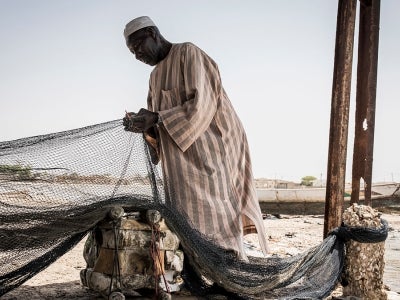
Chinese commercial fishing boat surrounded by seagulls
The Yellow Sea Large Marine Ecosystem (YSLME) is a semi-enclosed body of water between the People’s Republic of China and the Korean Peninsula. This shallow sea has an area of about 400,000 km2 and boasts a wide variety of habitats and a high level of marine biodiversity, but the coastline is heavily populated, urbanized, and industrialized. Fisheries have become increasingly important to the region: total annual landings have increased from 425,000 tonnes in 1986 to an average 2.40 million tonnes in 2003 and 2004. The People’s Republic of China has been harvesting the lion’s share of the catch, averaging approximately 92.6% of the total catch over this period. The number of fishing vessels has risen from about 100,000 in 1986 to an average of 140,000-150,000 in 2004. Not surprisingly, the Yellow Sea has been identified as one of the LMEs most detrimentally impacted by human development.
In 2004, recognizing that sustainable management was essential for continuing exploitation of the natural resources that the Yellow Sea provides, the People’s Republic of China and the Republic of Korea partnered with UNDP in the Reducing Environmental Stress in the YSLME Project (Phase 1). The primary focus was to secure sustainable fisheries management and reduce environmental stresses on the YSLME, which placed this project in a unique position to improve cross-border collaboration between the People’s Republic of China and the Republic of Korea. In addition to the two participating countries, the project also successfully involved the Democratic People’s Republic of Korea (DPRK) as an observer in some of the major project activities
Joint regional cruises and fishery stock assessments (both new to the region) were examples of early project activities that contributed to building trust and provided a firm footing for regional cooperation. These activities gathered the information needed to create a regional analysis of the status and trends in fisheries. The analysis served as a baseline for future studies and helped identify shared challenges. The technical, logistical, and political difficulties that arose while these joint tasks were being conducted were resolved collectively by team members from both countries. This was a clear sign of their willingness to work together and find solutions.
A landmark success of the YSLME Project has been the agreement between the People’s Republic of China and the Republic of Korea to reduce the size of the fishing fleet by 30%. The agreement set a precedent in the region with respect to cooperation and establishment of mutual trust and confidence and will help reduce the pressure on fish stocks. In order to alleviate some of the economic impacts on fishermen, the countries have been undertaking boat buy-backs and providing training on alternative livelihoods. Complementary achievements include signing joint agreements to reduce nutrient discharges by 10% every five years, creating a regional network of marine protected areas, promoting sustainable mariculture using baskets in deeper waters to overcome the problem of converting the coastal ecosystems to ponds for aquaculture, and continuing joint regional stock assessments.
Despite some formidable obstacles, the YSLME Project has helped stimulate a new era of cooperation and environmental progress. Encouraging signs include evidence that the total biomass of the Yellow Sea has been slowly recovering. Building on the successes of Phase 1, which was completed in early 2014, the People’s Republic of China and the Republic of Korea have committed to implement the agreed SAP priorities through a new GEF/UNDP project to secure international, multilateral coordination and cooperation.
This story was orginally published in "From Coast to Coast: 20 Years of Transboundary Management of our Shared Oceans" in 2015.


